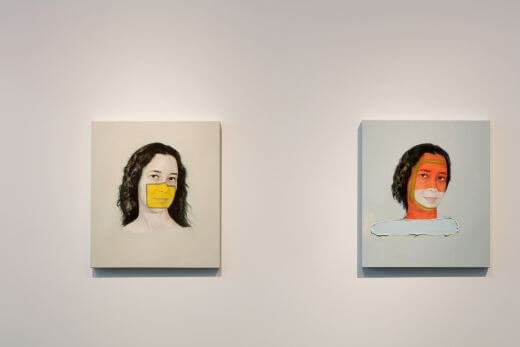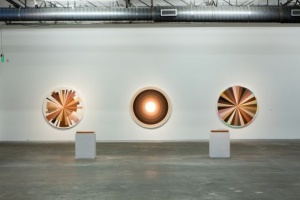- A JOURNEY BETWEEN THE BOSPHORUS AND THE SEA OF MARMARA: Impressions from the Istanbul Biennial

- MĂIASTRA: A History of Romanian Sculpture in Twenty-Four Parts
FROM POTTERY TO POPULATION DATA: The Diverse Influences of Adriana Varejão
Alina Cohen

Adriana Varejão, Kindred Spirits, 2015. Oil on canvas, 52 x 45.5 cm. Courtesy Dallas Contemporary
“I was just sitting there, talking with her,” Alonzo says. They were at her home in Brazil. “She said, ’I want to keep working while we speak.’ She started stabbing a canvas, spreading it open. She was this very young woman with a knife. It was such a dramatic gesture.” And an inspiring one—since that first meeting, Alonzo has closely followed her practice. This fall, Alonzo opened Kindred Spirits at Dallas Contemporary, an exhibition of Varejão’s work that features a new series of paintings created specifically for the museum.
Like much of Varejão’s oeuvre, these new works explore cultural identity. The Kindred Spirits paintings, from which the exhibition takes its name, feature Varejão’s portraits overlaid with colorful shapes and symbols. In one, a yellow square with a dark outline covers Varejão’s nose and mouth. In others, feathers and earrings appear. In some, Varejão’s face is cut off, or markings and borders
appear adjacent to it.
It is easy to mistake the Kindred Spirits paintings for self-portraits. But the paintings were actually made by Chinese fabricators. Varejão sent photographs of herself to a studio in China that reproduced the images, raising questions about authorship and the multiplicity of sources required to create a work of art. Through the Kindred Spirits series, Varejão transforms reproduced photographic images manufactured by an anonymous foreign service into works worthy of an exhibition at an elite art institution.
Each painting contains its own unique references, a feat of both imagination and extensive research. The markings derive from two sources: American art history and Native American imagery. Varejão has typically focused on Brazil, her home country, as well as Portugal and China, countries to which Brazil’s colonial history is linked. This is the first show in which she explores North America.
Varejão uses elements of the works of seminal American artists, including Donald Judd, Agnes Martin (who also referenced Native American pottery in her own art), Georgia O’Keefe, and Llyn Foulkes. Markings taken from Native American face painting appear in other works. By interspersing these paintings along the wall, Varejão eliminates any hierarchy or distinction between Native American traditions and modern American art. In the gallery, the paintings are installed in a row, so that viewers must look at each, one by one. No single painting is given a prominent position. Hanging the paintings at the same height eliminates any physical hierarchy or privileging of one over another. Additionally, none of the Kindred Spirits works carries a unique title. They’re each simply and impartially referred to as Kindred Spirits.
“It’s difficult to distinguish the exact references in the Kindred Spirits paintings,” said Alonzo. “When I first looked at them, I thought one referenced pottery when it was really Sol Lewitt.” Alonzo highlights this confusion as the moment when he knew that Kindred Spirits was the correct name for the show. “I’m an expert and I was tricked!” he says. Minimalist Paintings was the original title, but Alonzo and Varejão realized that it was just too narrow. Artists such as O’Keefe and Foulkes certainly didn’t fit under the “minimalist” title, and the show was much more than a riff on a specific art historical movement. Instead, the show’s title emphasizes the connections among seemingly disparate artists and cultures. Native American pottery is of equal value within art discourse and the practice of art making itself.
There are echoes of similar themes in Varejão’s series of Mimbres paintings. Composed of oil and plaster on canvas, these works take their inspiration from the pottery of the Mimbres, a Native American tribe. Varejão describes them as “tri-dimensional.” Though they have a sculptural quality in their three-dimensionality, Varejão adamantly sees herself as a painter.
Alonzo recalls visiting the Yale Peabody Museum of Natural History, in New Haven, Connecticut, with Varejão, where she first saw the Mimbres pottery. “We were looking at shards of pottery. Adriana said, ‘What is that? Why are they shards?’” Alonzo recalls. The answer was elusive. “The shards were found in tombs. We don’t know what happened, but perhaps the vessels were destroyed to release spirits. There were these ‘kill holes’ at the bottoms of the vessels.”
This idea stuck in Varejão’s mind. In her Mimbres paintings, the surfaces are cracked, lending them a three-dimensional, sculptural quality. Like an eggshell, the cracks seem to be the product of something internal trying to escape. There’s a suggestion of a spirit within the painting itself. Varejão’s paintings assume a mystical quality as they ask viewers to consider what’s behind the cracks and what emerges from a work of art.
Alonzo also emphasizes the size of the Mimbres paintings. “They’re big,” he says. At five feet square, they’re much larger than the pottery shards that inspired them. They demand attention. Varejão also painted the sides of the canvases; when visitors walk into the gallery, they see the detailing on the sides before the fronts of the works themselves. Literally and figuratively, there are many perspectives from which to view and interpret the work.
The Kindred Spirits paintings face the Mimbres paintings. Varejão says that the organization of her works creates “good balance and rhythm.” With this set-up, each representation of Varejão confronts the Mimbres works. Varejão’s subtle smiles take on new meaning, perhaps of reverence and gratitude, when they appear directed toward the Mimbres series, representative of a tradition from the past that so inspired her.

Adriana Varejão, Polvo Color Wheel, 2015. Oil on canvas, three canvases, diam: 52 cm each. Installation view: Kindred Spirits, Dallas Contemporary, 2015. Courtesy Dallas Contemporary
On the wall in between these series hang the Polvo color wheels, for which Varejão examined a Brazilian government census from the 1970s that asked the population a non-traditional question: What color are you?
“The response was very Brazilian,” says Alonzo. Instead of conventional colors—red, brown, white, yellow—responses varied from “coffee with milk” to “kissed by the sun.” Varejão attempted to translate these lyrical responses into workable colors. She created thirty-three tubes of oil paint. With these new hues, she painted the Polvo color wheels. While they resemble tools from an art class, the context lends them a new political dimensions.
“What I love about the color wheels is that they could be demographic pie charts,” says Alonzo, “showing you how large the population of ’coffee with milk’ people are. They show how arbitrary these things are. The idea of racial purity is ridiculous. Humanity has been mixing since the dawn of time. Adriana is ques- tioning ideas of purity and taxonomy of race and color.” As she does in Kindred Spirits, Varejão undermines hierarchies and preconceived cultural notions. In the color wheels, she also gives voice to individual Brazilian perspectives.
![3. Adriana Varejao_Tintas Polvo[Polvo Oil Colors]_2015](https://www.miamirail.org/wp-content/uploads/2015/11/3.-Adriana-Varejao_Tintas-PolvoPolvo-Oil-Colors_2015-300x200.jpg)
Adriana Varejão, Tintas Polvo, 2013. Wooden box with acrylic cover containing 33 aluminum oil paint tubes, 36 x 51 x 8 cm, edition 161/200 Adriana Varejão, Polvo Color Wheel, 2015. Oil on canvas, three canvases, diam: 52 cm each. Installation view: Kindred Spirits, Dallas Contemporary, 2015. Courtesy Dallas Contemporary
Justine Ludwig, the director of exhibitions at Dallas Contemporary, notes the city’s positive reaction to Varejão’s work. “People see themselves in the show,” she says. “It echoes the diversity of Dallas.” The Polvo color wheels particularly appeal to art students. “They speak about color studies,” she says. Through the lens of race, a color wheel adopts new connotations. Many visitors, according to Ludwig, approach the Kindred Spirits works as a game, trying to guess the refer ences Varejão used for each piece.
Varejão is quick to reject the association of an artist, or any individual, with the boundaries of a particular region. “It does not make sense to me to think of art in terms of geography,” she says. “Contemporary art is related to individuals.” She explains that “miscegenation,” links the Mimbres series, Kindred Spirits paintings, and color wheels that “in this specific group can either be cultural or racial.”
Alina Cohen is a Brooklyn-based arts and culture writer.








